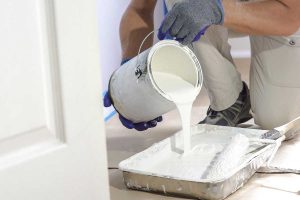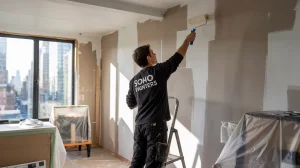Volatile Organic Compounds (VOCs) have become a crucial consideration for homeowners embarking on painting projects, yet many remain unaware of their significance and potential impacts. These chemical compounds, which readily evaporate at room temperature, are present in many traditional paint formulations and can significantly affect both human health and the environment. As awareness grows about indoor air quality and environmental sustainability, understanding VOC levels in paint has never been more important for homeowners making informed decisions about their living spaces.
The paint you choose for your home is more than just a color decision – it’s a choice that can impact your family’s health and the environment for years to come. Whether you’re planning a simple room refresh or a complete home makeover, understanding VOCs should be at the forefront of your paint selection process.
Key Points to Consider:
- VOCs continue to off-gas long after paint appears dry
- Indoor VOC levels can be up to 10 times higher than outdoor levels
- Paint choice affects both immediate and long-term indoor air quality
Understanding VOCs in Paint
Volatile Organic Compounds are carbon-containing substances that easily become vapors or gases. In paint, these compounds serve several essential functions, including acting as solvents, facilitating proper drying, and ensuring smooth application. Traditional oil-based paints typically contain higher VOC levels than water-based alternatives, though both types may include these compounds.
Common VOCs found in paint include:
- Benzene
- Formaldehyde
- Toluene
- Xylene
- Ethyl acetate
These chemicals play vital roles in paint performance, contributing to durability, coverage, and flow characteristics. However, their presence comes at a cost to human health and environmental quality. During application and curing, VOCs are released into the air through a process called off-gassing, which can continue for months or even years after application, though at decreasing levels.
The chemistry behind VOCs in paint is complex, involving interactions between resins, pigments, and additives. Understanding these relationships helps explain why simply removing VOCs isn’t always straightforward – they often contribute to the paint’s fundamental properties and performance characteristics.
Health Impacts and Risks
The health effects of VOC exposure can range from minor irritations to serious medical conditions, depending on various factors including concentration levels, duration of exposure, and individual sensitivity.
Short-term health effects may include:
- Headaches and dizziness
- Eye, nose, and throat irritation
- Nausea and vomiting
- Worsening asthma symptoms
- Allergic skin reactions
Long-term exposure risks are more concerning:
- Liver and kidney damage
- Central nervous system damage
- Possible links to certain cancers
- Chronic respiratory problems
- Endocrine system disruption
Certain populations are particularly vulnerable to VOC exposure:
- Pregnant women and developing fetuses
- Young children and elderly individuals
- People with existing respiratory conditions
- Those with compromised immune systems
- Individuals with chemical sensitivities
Indoor air quality is significantly impacted by paint VOCs, especially in newer, more airtight homes where ventilation may be limited. Studies have shown that indoor VOC levels can persist at elevated levels for weeks or months after painting, potentially creating long-term exposure scenarios for occupants.
Environmental Considerations
Beyond human health concerns, VOCs pose significant environmental challenges. When released into the atmosphere, these compounds participate in photochemical reactions that contribute to smog formation and various forms of air pollution.
Environmental impacts include:
- Ground-level ozone formation
- Contribution to urban air pollution
- Potential groundwater contamination
- Effects on plant and animal life
- Climate change implications through atmospheric reactions
Regulatory bodies worldwide have recognized these environmental concerns, leading to increasingly stringent controls on VOC content in consumer products, including paint. The paint industry has responded with innovations in low-VOC formulations, though challenges remain in balancing environmental responsibility with product performance.
VOC Regulations and Standards
Understanding the regulatory landscape helps homeowners make informed decisions about paint selection. In the United States, VOC regulations vary by region and jurisdiction, with some areas implementing stricter standards than federal requirements.
Current regulatory framework includes:
- EPA national VOC limits for architectural coatings
- SCAQMD (Southern California) stringent regional standards
- Green Seal and other third-party certification programs
- LEED building standards requirements
- State-specific regulations and guidelines
The most stringent standards typically come from California’s SCAQMD (South Coast Air Quality Management District), which often serves as a model for other regions. These regulations set specific VOC limits for different types of coatings:
- Flat paints: 50 g/L or less
- Non-flat paints: 100 g/L or less
- Primers and sealers: 100 g/L or less
- Floor coatings: 100 g/L or less
Low-VOC and Zero-VOC Alternatives
The market now offers numerous alternatives to traditional high-VOC paints, with options suitable for virtually every application. Understanding these alternatives helps homeowners make appropriate choices for their specific needs.
Low-VOC paints typically contain less than 50 grams per liter of VOCs for flat finishes and less than 150 grams per liter for other finishes. Zero-VOC paints contain less than 5 grams per liter of VOCs, though colorants added at the point of sale may increase these levels slightly.
Advantages of low-VOC options:
- Reduced health risks
- Minimal odor during and after application
- Faster room reoccupancy
- Easier cleanup (water-based formulations)
- Environmental benefits
Performance considerations:
- Coverage may require additional coats
- Drying time variations
- Durability improvements in newer formulations
- Cost premium over traditional paints
- Color selection and consistency
Best Practices for Homeowners
Making informed decisions about paint selection and application can significantly reduce VOC exposure and ensure optimal results.
Selection Guidelines:
- Read product labels carefully
- Look for third-party certifications
- Consider the specific application needs
- Factor in environmental conditions
- Compare costs including coverage rates
Application Recommendations:
- Ensure proper ventilation during and after painting
- Follow the correct painting order
- Use appropriate safety equipment
- Plan for adequate drying time
- Consider professional application for large projects
Ventilation Requirements:
- Open windows and doors when possible
- Use fans to circulate air
- Continue ventilation for 2-3 days after painting
- Monitor indoor air quality
- Allow proper drying time
Conclusion
The choice of paint involves balancing various factors including health concerns, environmental impact, performance requirements, and cost considerations. As VOC regulations continue to evolve and manufacturers develop improved low-VOC formulations, homeowners have increasingly better options for achieving their desired results while protecting health and the environment.
Key takeaways for homeowners:
- Prioritize health and environmental considerations
- Research products thoroughly before purchase
- Implement proper application procedures
- Maintain adequate ventilation
- Consider professional assistance when needed
The future of paint technology continues to trend toward lower VOC formulations without compromising performance. Homeowners who stay informed about VOC levels and their implications can make choices that protect their families while achieving beautiful, durable results in their home improvement projects.
Contact Soho Painters today for a free interior painting estimate for your apartment or office!





